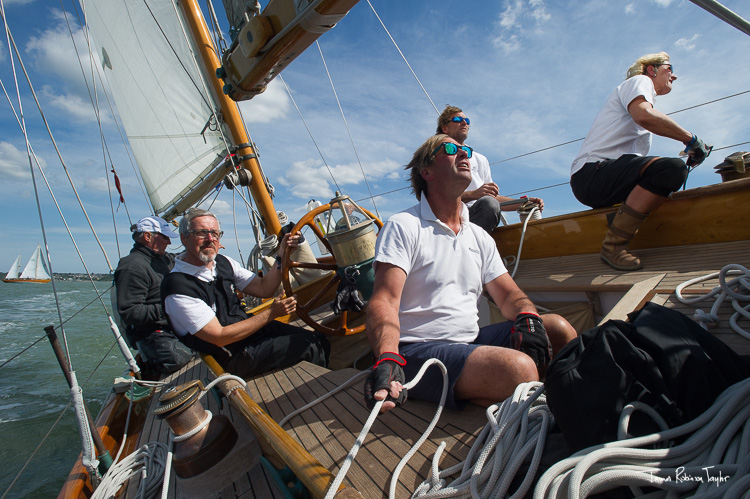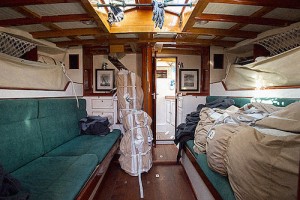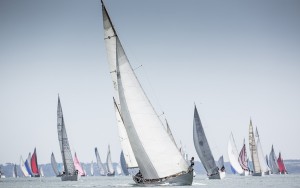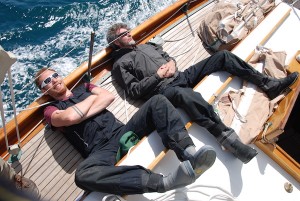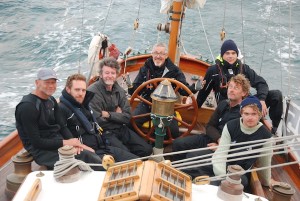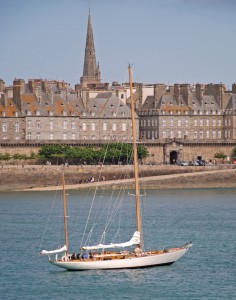The Cowes–Dinard race is a 151NM qualifying competition for the Fastnet. Dan Houston joins Griff Rhys Jones aboard the S&S yawl Argyll for an overnight offshore race to remember
It’s ten to three in the morning when the spinnaker blows. Suddenly the ghostly white expanse of energy billowing in front of me is gone, replaced by a dark cloud-scudded hole the wind is pouring through. My first thought had been how quiet it was; it just fell away in less than a second. I’d been sitting in my position on the windward deck next to the mast, as the wind had been building up to the forecast NW F6, and I had felt the strengthening pull on the long sheet running over the deck to the cockpit winch. Now the sheet goes slack and I jerk to my feet.
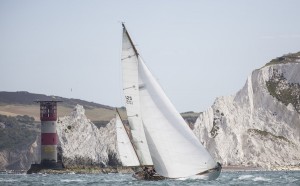
It looks like we have the Needles to ourselves as we are in the fore of the 170 strong fleet. Photo Lloyd Images
My headtorch, which had been occasionally useful to see the set of the upper tell tales, picks out the bunt of the sail dragging in the water. An inch or two of luff remains with its bosomy curve still pulling ahead in the wind. Hands materialise on deck and in a few seconds the torn A2 is in, and in a minute or so more its slightly smaller brother is ready to hoist. There is no discussion as to whether even this might be too much sail. We are racing, and we need to power on.
There’s not too much shouting on Argyll, but as I’m on the halyard winch winding the head of the sail up to the block I am urged on in my task. I put my back into it as a gust of wind pulls a few precious inches of rope through the winch, and we put on a fourth turn. Forcing the half turns I decide the excercise is aerobic, my head feels suddenly light as my shoulders begin to burn. I feel guilty; everything happened so quickly and smoothly until it was my turn to persuade this sail upwards in this dark windy night. I’m disgusted by the office flab; where did my youth go?
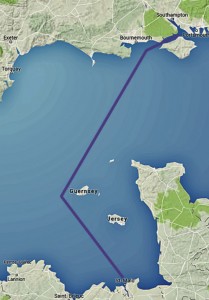
Our 151nM track. The Cowes-Dinard-St Malo offshore race is one of the oldest in the RORC calendar, with its origins in a pre World War I race from Cowes to St Malo bay. The winner still receives the original trophy – the magnificent King Edward VII Cup, which dates from 1906.
The new sail fills the hole and harnesses the wind. Argyll is racing off again, with her fast elegant reaching gait. I stand on deck trying not to pant too loudly and admire the dark water, marbled by her bow wave, coursing by.
I’d like to stay awake, to savour the night. This is my first time racing offshore on a Sparkman and Stephens inboard yawl. And I can now connect back to those guys in the 1930s on Dorade or Stormy Weather who won the Fastnet in the early days of British offshore racing. They’d have had nights when it felt like this; the gear breaking, the intense activity to make safe, repair or replace kit, and carry on.
These yawls are still revered for their seaworthy fast design; we witnessed it earlier as we pulled ahead in the fleet, enjoying a spectacular hour or so racing down the Western Solent after getting late to the start line, and crossing a minute or two after the gun. The dishy modern glassfibre boats should have been passing in numbers – you’d have thought, but as we tripped past the Needles many are eating our wake, though I notice a sistership Stormy Weather maintains her bearing out to windward. It’s true that we are in our best element: a fine-ish reach to cross the Channel in a south-easterly F3 which is quite a rare wind even in summer.
I’m reminded of a time when I met Olin himself, in Palma Mallorca; in his eighties, he was still involved in offshore racing, attending a conference on the rules. He kindly agreed to let me buy him dinner and told me about his legendary design career. He was a designer who acutely understood the rules, and developed his designs to beat them. But as we polished off the wine he told me that if there were no rules to design to then he would design a boat like Dorade every time. “For the combination of speed and seaworthiness,” it would have to be Dorade, he said.
And you can see why he said that. This yawl Argyll is comfy, as she slides through the water. The crew come on watch with a little coffee, made from the coffee machine which perches nonchalently on the side in the galley. They don’t have to be dressed in wet weather gear all the time; the mate Ollie Graffy wears his Cornish smock and there’s a sense of ease. The motion is partly due to a massive lead keel heaving against our buoyancy and keeping everything cushioned in the seaway.
That huge keel gave this type of design the nickname of leadmine. And it feels like that as you go below; you seem to carry on down further than you expect! With nearly a one in five beam to length ratio Argyll is nearly as narrow as Dorade (not racing here) though she is longer and this helps with the comfort factor at sea as well. It feels good that we don’t even have to be on the windward rail, like a little row of ninepins for
Poseidon’s spray; every time I look around someone has his tobacco out, which I doubt is happening on many of the other boats.
Interestingly Matt Brooks, the owner of Dorade said of racing her offshore (after re-winning the Transpac in 2013): “We kept the tiller in the centre. Constant, small corrections are enough, and we learned that keeping the weight low down in the middle of the boat worked better than sitting out high side.” You might think such a remark was pure conjecture, or based on what some of the old hands said about their experience sailing a comparitively heavy long-keeled classic, but Matt had actually made polar charts sailing with crew out on the rail, or deep and central in the cockpit. He proved it for the design!
But please excuse my manners dear reader, I should do some introductions. This boat belongs to Griff Rhys Jones, comedian and television presenter who is also a lifelong sailor, though mainly a cruiser, until a few years ago. His 2003 book To the Baltic With Bob is an epic cruise in a wooden boat – Undina, which he kept on the east coast.
He began racing with the British Classic Yacht Club and became so keen on competition that after he bought Argyll he started his own quirky regatta – Yawlba, which is for yawls, yes just for yawls only, and takes place in Elba. Having no sponsorship from a major posh watch maker he gives the winner a Swatch – and apparently the timepieces are highly prized.
Griff keeps Argyll in an enviably polished, showroom condition, with a French skipper Alex Bordessoule and mate Ollie. Long term racing crew include Baines (“it’s just Baines”), Norwegian Lars Landfald and Rory. We are also joined by Ben Risley, cameraman (Griff is thinking about making a film of the Fastnet) and our navigator Roger Ford.
Roger’s earlier plan, that we should sail down the land (rather than the island) side of the Solent had paid off and we had had clearer breeze with a good angle to get out into the Channel. We left the Needles before 10.00am and like a lot of the fleet headed up to get clear air with the wind fine on the bow. But we were soon able to lay a course to west of the Casquets. Speaking later Roger explained: “I wanted to be a mile west of the Casquets when the wind changed and backed to the forecast NW. And we sailed on a simple bearing for the Hanois light (West tip of Guernsey); rather than stay on a straight line (over the ground) which would have put us more against the tide. So the tide took us west for a couple of hours and then back east.
“When we got to the Casquets (about 7pm) I was concerned we weren’t far west enough, but then I saw Stormy Weather was east of us so I stopped worrying! The wind changed around 10pm and we gybed as the tide turned back west. Around that time a wind warning came over Channel 16 about a F6 imminent from the NW. And as we know that did happen.”
For Roger it was the first time sailing a yawl like this and this was his trial race before another Channel race and then the Fastnet itself.
After the spinnaker evolution I arrive on deck after a some sleep to witness Argyll crossing the line. The leaden sky begins to brighten and we realise we have done extraordinarily well. Our finish time of 0520 is fully 40 minutes ahead of Stormy Weather (although we don’t know this timing accurately until a bit later) and there is a great sense of achievement, although after a 22- hour sail no-one is whooping.
It’s been a long time since the evening meal and we grab bread and cheese. And coffee.
Griff takes it in his stride. His mind is already on the Fastnet but it is a fabulous achievement. It turns out we are the fastest British boat on elapsed time, coming fourth overall of the 173 entries and first in class (IRC4) by nearly 40 minutes.
We enter the yacht basin where half a dozen boats and wan-looking crew are jilling for a space to tie up. Griff is returning straight home, he will leave the prize taking to captain Alex – to whom he gives full credit for “fettling up the boat to racing condition”.
I say I’ll go too. Ben the cameraman will join us. We go to find a ferry ticket and to see the race office where RORC Commodore Michael Boyd greets Griff with enthusiasm.
It’s time for some breakfast though really it feels like we should have a beer… so we do. We can reflect on an almost perfect performance. There was only the spinnaker blowout (and a time earlier in the Solent when its tack line had snapped) to be any cause for discussion, but it’s left; breaking things is worth it if you win.
We leave for the ferry before noon. A trip that turns into a 12 hour ordeal as the fast cat from Guernsey to Poole is a delayed connection. Griff passes the time with tales of when he used to drink, at the Groucho. And as I get home, I pray that Olin still knows how we love his boats. ★
Main photo James Robinson Taylor , on board shots: Dan Houston; Solent shots: lloydimages.com
From Classic Sailor No1


